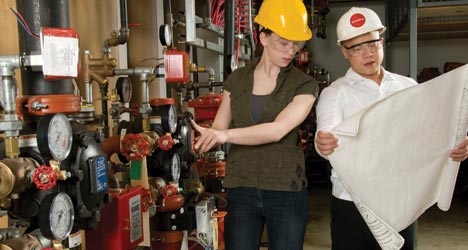What is clean steam?
Clean steam is used in the pharmaceutical and healthcare industries in processes where the steam or its condensate can come into contact with a pharmaceutical or medical product and cause contamination. In such cases, steam from a conventional boiler(often called utility or plant steam)is unsuitable because it may contain boiler additives, rust or other undesirable materials.+
The use of clean steam is determined by the rules of Good Manufacturing Practice (GMP). These are general rules applicable to pharmaceutical manufacture,detailed in the Code of Federal Regulations(CFR Title 21,Part 211). They do not provide any specific recommendations regarding steam, but do present the general requirements offacilities, systems, equipment and operation needed to prevent contamination of pharmaceutical products during their manufacture.
Uses of clean steam:
The main use of clean steaming pharmaceutical manufacturing is for the sterilization of products or, more usually, equipment. Steam sterilization is encountered in the following processes:
- Manufacture of injectable or parenteral solutions, which are always sterile.
- Bio-pharmaceutical manufacturing, where a sterile environment must be created to grow the biological production organism(bacterium, yeast or animal cell).
- Manufacture of sterile solutions,such as ophthalmic products.
Typically in these processes, clean steam is injected into equipmentor piping to create a sterile environment, or into autoclaves where loose equipment, components (such as vials and ampoules)or products are sterilized.
Clean steam may be used for some other functions where conventional utility steam might cause contamination, such as:
- Humidification in some clean rooms.
- Injection into high purity water for heating prior to Clean-in-Place (CIP) operations.
Fundamentals of clean steam system design:
Avoidance of corrosion
Unlike utility steam, clean steam has no corrosion inhibitors. Also, low conductivity water or condensate is hungry for ions, causing it to be corrosive to many materials commonly used in utility steam systems. Carbon steel,gunmetal and bronze, all commonly found in utility steam components, would all be rapidly corroded. Metal components for clean steam systems are therefore usually AISI 316 L stainless steel, or sometimes titanium. Non-metallic materials used include EPDM and PTFE.
Then eed to avoid corrosion is not only necessary for safeguarding the integrity of equipment. Corrosion products entering the clean steam could potentially cause contamination of the pharmaceutical product, either as chemical or particulate contamination.
Even where 316l stainless steel is used, a particular form of corrosion, called “rouging”, is often encountered in clean steam systems. The passive layer on the steel surface is disrupted and a red/brown/black film develops over time. Often this film is stable and does not pose a threat to the pharmaceutical product. Sometimes a powdery film develops and this can detach from the steel surface and cause discoloration of equipment which the steam contacts.
If this occurs, and the manufacturer feels that there is a risk of contamination or discoloration of the product, then the clean steam generator or even the full distribution system may be cleaned (“derouging”).
A variety of methods are used, but they all involve a chemical treatment to remove the surface layer of steel – this is essentially an etching process. After de-rouging, a passivation process must be used to restore the passive layer on the steel surface, since it is the passive layer that is responsible for corrosion resistance.
Preventing entry of contaminants into the system
Clean steam must be free of contaminants at the point of use. Chemical and microbial contaminants can enter steam systems in a variety of ways, and in the design of clean steam systems this must be avoided. Pathways for contamination include leakage, air being pulled into the system and “grow through” from a contaminated external environment.
Preventing microbial growth in the system
Steam at typical operating pressures will kill bacteria and their spores, so the parts of a clean system that are continuously exposed to steam will be sterile. However, if condensate is allowed to collect in the system, and it cools, then stagnant water can provide a suitable environment for bacterial growth. Though these bacteria may be killed when the condensate is discharged into equipment, followed by steam, their breakdown products, including endo toxins, may still be present. Endo toxins are not destroyed by typical clean steam system temperatures.
Looking for a clean steam system design consultant? Look no more, contact Panorama now!




Recent Comments